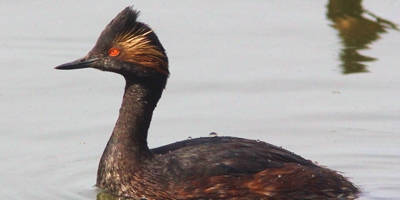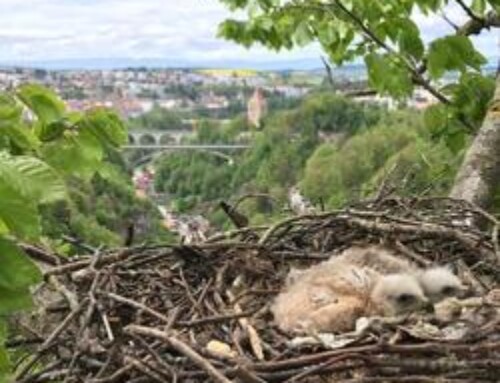Differential mobilization of fat-stores in migrating birds: showcasing Eared Grebes
LINKED PAPER
Rapid mobilization of abdominal fat in migrating Eared Grebes. Straker, L.C. & Jehl, J.R., Jr. 2016. Journal of Avian Biology. DOI: 10.1111/jav.01007. VIEW
Bird migration has become a hot topic over the past few decades, with incredible advances. These include the development of different technologies to gather data from live or dead birds (e.g. GPS, weather radar, Magnetic Resonance Imaging, and Computed Tomography Scanning – CT). They also involve the ever increasing interest of the public, which led to the explosion of Citizen Science resources, such as websites where birdwatchers and scientists upload observations and interact with the data (e.g. eBird, xeno-canto, wikiaves).
Although we still know very little about most migratory birds, we do know that birds use some basic strategies for migration. Some fly short distances, eating along the way (similar to what doctors and nutritionists recommend – eat small portions many times a day); and others fly long distances, which requires building up energy/fat reserves for the whole journey, thus eating a lot before the exercise (not a recommended program for humans). Eared Grebes Podiceps nigricollis fly long distances, stopping at appropriate sites with water, such as lakes or coastal sites to refuel.
In North America, grebes migrate from their breeding grounds in the north to southern California or Mexico, stopping over on the way (staging period) at the Great Salt Lake (GSL) in Utah or the Mono Lake in California. In this movement, to GSL, they fly about 1500 km over 2-3 nights and rest by day (Jehl and Henry, 2010) (Fig. 1).
During their staging period, they molt and undergo major changes in body composition, in which they reduce flight muscles, and enlarge the digestive organs to process all the shrimp they’ll eat to gain the weight needed for the next stage of migration (Jehl, 1997). After a few weeks, these birds are obese (> 600 g) and flightless. At this point, food starts to run out, which induces the birds to reverse these body changes and readies them for their southward departure (Jehl, 1988). They still need to have enough stored fat to power this flight, a distance of about 1000 km (Fig. 1).

At this point many questions start to pop up.
These birds take off from GSL weighing roughly a third more of what they’ll weigh on arrival at the Gulf of California (e.g. ~460 g -> ~300 g). This means that within ~12 hours of constant flapping, each bird will reduce its weight by 40%, mostly in fat. Although impressive, it is common for long distance migrants. So, where is all that fat being stored? The Eared Grebes, similar to other vertebrates, have discrete fat stores (depots) that fill up as the bird gets fatter, and shrink as the fat is mobilized. By reconstructing the size and location of depots using CT imaging, we found that the grebes store a lot of the fat in the abdominal cavity (see videos below). This was somewhat expected, since the digestive organs are reduced at the end of the staging period, creating space in this cavity. And since most of the fat is stored in the rear end of the bird, it may act as a counterweight to the big and heavy flight muscles in the anterior. The amount of fat observed, from the greatest to the smallest volume, was as follows: abdominal [posterior] > thorax [mid] > chest [anterior].
Video 1 Computed Tomography Scanning (CT) reconstruction (The Horos Project, v1.1.7) of Eared Grebes Podiceps nigricollis. The skeleton is visualized in white, muscles and organs in red and fat depots in yellow. Birds leaving the Great Salt Lake, UT (GSL), have an average weight of 450 g (shown bird: 469 g). Note how the fatty tissue envelops the body continuously, and fills the abdominal cavity.
Video 2 Computed Tomography Scanning (CT) reconstruction (The Horos Project, v1.1.7) of Eared Grebes Podiceps nigricollis. The skeleton is visualized in white, muscles and organs in red and fat depots in yellow. At arrival, birds have an average weight of 250 g (shown bird: 238 g). Note how little fatty tissue is left. However, the chest fat depot still concentrates some fat, indicating its slower mobilization.
If different regions of the body stored different amounts of fat, would the fat be mobilized equally throughout the body? In this study, we could not test the fattening pattern, but we were able to see how fat would be mobilized in a migrating Eared Grebe. The losses were not random. Abdominal fat was mobilized much faster than the other regions: 2x faster than that of the thorax, and 4x faster than that of the chest.
Why is that? What determines the rate and location of fat catabolism? This question is still unanswered. It could be because different fatty acids are preferentially stored in different depots, or because the abdominal fat is more closely located to the bird’s liver (high demands on the liver to metabolize all the fat into smaller and easier-to-use molecules), or even an unknown reason. Either way, Eared Grebes do make one a bit jealous… They can eat all the shrimp they want, nearly to the point of “bursting”, but in a one-night exercise burn off most of the fat, preferentially from the belly – beer drinkers might find that interesting – and they become thin again. Unlike humans who need to sweat so much to burn that last bit of belly fat, which seems to refuse to go away no matter what! These birds are preferentially mobilizing abdominal fat.
Comparisons with humans aside, the overweight take-off and the rapid mobilization of abdominal fat during migration could have some interesting effects on the flight dynamics of these birds. To test this, however, is easier said than done. As Eared Grebes are night flyers and rest by day, footage of these birds in flight is rare, which increases the challenges to understanding their flight mechanics and kinematics. Okay, so they do not fly frequently, but when they do, they migrate hundreds of kilometers in a single night. Like commercial airplanes, they need to carry a huge fuel fraction to complete a non-stop flight. So grebes are very interesting birds in many aspects and a better understanding of their physiology could even lead to applications in aeronautics, as well as weight loss strategies.
Further reading
Straker, L. C., & Jehl, J. R., Jr. 2016. Rapid mobilization of abdominal fat in migrating Eared Grebes. Journal of Avian Biology. DOI: 10.1111/jav.01007. VIEW
Jehl, J. R., Jr, & Henry, A. E. 2010. The postbreeding migration of Eared Grebes. The Wilson Journal of Ornithology. 122(2): 217–227. VIEW
Jehl, J. R., Jr. 1997. Cyclical changes in body composition in the annual cycle and migration of the Eared Grebe Podiceps nigricollis. Journal of Avian Biology. 28(2): 132-142. VIEW
Jehl, J. R., Jr. 1988. Biology of the Eared Grebe and Wilson’s Phalarope in the non-breeding season: a study of adaptations to saline lakes. Studies in Avian Biology. 12. VIEW
Image credit
Featured image: Eared Grebe Podiceps nigricollis © Chet McGaugh
If you want to write about your research in #theBOUblog, then please see here.






